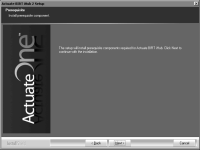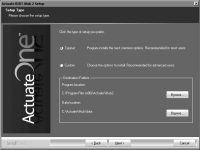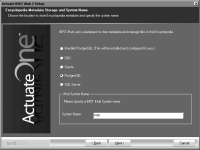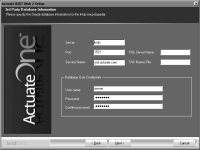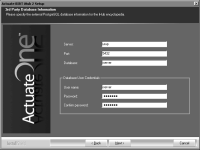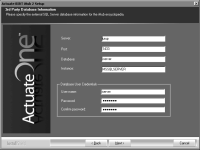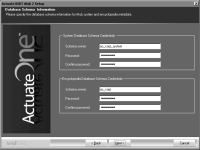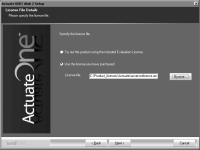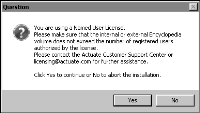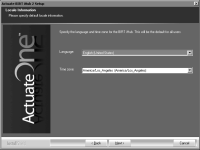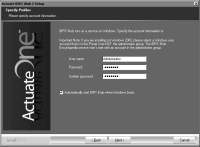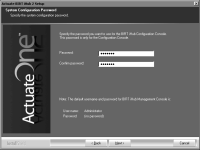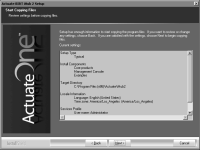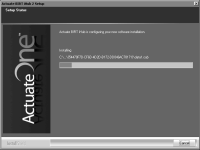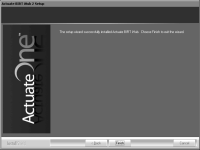How to install an Encyclopedia volume that uses an alternative database
1 Download the iHub distribution package from an FTP software distribution site. Extract the files. Run the self-extracting executable file, ActuateBIRTiHub.exe. The welcome message appears, as shown in
Figure 3‑1. Choose Next.
Figure 3‑1 Viewing the welcome message
2 Read and accept the license agreement, as shown in
Figure 3‑2. Choose Next.
Figure 3‑2 Accepting the license agreement
3 The setup installs the prerequisite components that BIRT iHub requires, as shown in
Figure 3‑3. Choose Next.
Figure 3‑3 Installing prerequisites
4 In Setup Type, as shown in
Figure 3‑4, choose Typical to install a supported relational database management system (RDBMS) for the Encyclopedia volume, such as OOTB PostgreSQL or a pre-existing DB2, Microsoft SQL Server, Oracle or PostgreSQL RDBMS.
In Destination Folder, accept the default or choose a new destination folder for the Program and Data locations.
iHub uses the Program location to resolve the paths to all the binaries that it launches. The environment variable, AC_SERVER_HOME, points to the location of the iHub binaries. The default path for the program location is C:/Program Files (x86)/Actuate/iHub2.
iHub uses the Data location to store the iHub logs, Encyclopedia volume data, and other related data. The environment variable, AC_DATA_HOME, points to the iHub data location. The default path is C:/Actuate/iHub/data.
Choose Next.
Figure 3‑4 Specifying Typical setup type
5 In Encyclopedia Metadata Storage, select DB2, Oracle, PostgreSQL, or SQL Server to use as a pre-existing third-party database for storing Encyclopedia volume metadata. This example uses the PostgreSQL RDBMS, as shown in
Figure 3‑5. In System Name, type a name for the BIRT iHub system. Restrict the name to alphanumeric and underscore characters with an initial alphabetic character in the pattern [a-z][a-z 0-9]*. Do not use a hyphen.
Figure 3‑5 Choosing a third-party database
6 After you chose DB2, Oracle, PostgreSQL, or SQL Server in the previous step, 3rd Party Database Information appears. Depending on which alternative database you selected, provide the following database information. Then, choose Next:

DB2
For a pre-existing DB2 installation, type the server hostname. In Database, specify the name of the database, such as iserver. Type the port. By default, the port is 50000. You can leave IANAAppCodePage blank. In Database User credentials, specify the iserver application user and a password, as shown in
Figure 3‑6.

Oracle
For a pre-existing Oracle installation, type the server hostname and port. By default, the port is 1521.
In Service Name, type a valid service name, such as orcl.actuate.com, that identifies the Oracle database server on which you want to install the Encyclopedia volume metadata. Do not use just the system identifier (SID). Provide the complete reference to the server, including the domain. When using a service name, leave TNS Server Name and TNS Names File left blank. When using a Transparent Network Substrate (TNS) service, leave service name blank.
In Database User Credentials, specify the iserver application user and a password, as shown in
Figure 3‑7.
Figure 3‑6 Specifying third-party database information for DB2
Figure 3‑7 Specifying third-party database information for Oracle

PostgreSQL
For a pre-existing PostgreSQL installation, type the server hostname and port. By default, the port is 5432. In Database, specify the name of the database, such as iserver. In Database User credentials, specify the iserver application user and a password, as shown in
Figure 3‑8.

SQL Server
For a pre-existing SQL Server installation, type the server hostname and port. By default, the port is 1433. In Database, specify the name of the database, such as iserver. In Instance, type the SQL Server instance name. In
Figure 3‑9, Instance contains the SQL Server default instance name. Specify the iserver application user in Database User credentials, as shown in
Figure 3‑9.
Figure 3‑8 Specifying third-party database information for PostgreSQL
7 In Database Schema Information, type the system schema owner, password, and confirm the password in System Database Schema Credentials. Type the Encyclopedia database schema owner, password, and confirm the password in Encyclopedia Database Schema Credentials, as shown in
Figure 3‑10.
Figure 3‑9 Specifying third-party database information for SQL Server
Figure 3‑10 Specifying System and Encyclopedia schema passwords
8 In License File Details, select Use the license that you purchased. Choose Browse then navigate to and choose the license file, as shown in
Figure 3‑11. Choose Next.
Figure 3‑11 Specifying the license file
When installing using a named user license, a prompt appears advising you to check that the volume does not exceed the number of registered users authorized by the license, as shown in
Figure 3‑12.
Figure 3‑12 Viewing the named user license question
Choose Yes to continue the installation.
9 In Locale Information, choose Next to accept the default language and time zone, as shown in
Figure 3‑13.
Alternatively, choose the language and locale settings for your region.
10 In Specify Profiles, type the user name, password, and confirm the password for the account used to start the Actuate BIRT iHub service, as shown in
Figure 3‑14. The account must be a member of the Administrators group. Actuate recommends that you limit access to this account for security reasons.
Accept Automatically start iHub when Windows boots, as shown in
Figure 3‑14. If you deselect this option, you must start the service manually from Windows Services. Choose Next.
Figure 3‑13 Specifying locale information
Figure 3‑14 Specifying the account for running the iHub service
If prompted to add Log on as a service privilege, choose Yes.
11 In System Configuration Password, type and confirm a password for Configuration Console, as shown in
Figure 3‑15. For both Configuration Console and Management Console, the default user name is Administrator. The Administrator account for Management Console has no password initially. You can log in to these consoles and change the password settings after installing iHub. Choose Next.
Figure 3‑15 Specifying the password for using Configuration Console
12 In Start Copying Files, review the settings shown in
Figure 3‑16. Choose Next.
Setup Status displays an indicator showing how the installation is progressing, as shown in
Figure 3‑17.
Figure 3‑16 Reviewing settings before copying files
Figure 3‑17 Viewing setup status
13 Choose Finish to exit the wizard, as shown in
Figure 3‑18.
Figure 3‑18 Exiting the installation wizard
14 The installation program prompts you to install the online help from the following location, as shown in
Figure 3‑19:
http://www.actuate.com
Figure 3‑19 Viewing the install online help and manuals prompt
To install the online help and PDF manuals from this location, in Windows, choose Start➛ Actuate➛Update Documentation.
The installation program installs shortcuts on the desktop, as shown in
Figure 3‑20.
Figure 3‑20 Viewing iHub shortcuts on the desktop
These shortcuts provide access to the following iHub components:

BIRT iHub Management Console 2
Launches Management Console to set up user accounts and run designs

BIRT iHub 2
Opens Welcome to Actuate iHub from which you can log in to Information Console to perform tasks, such as accessing folders and viewing documents



